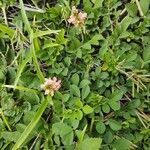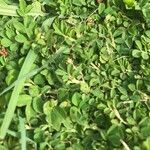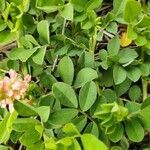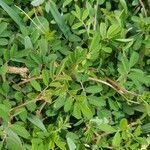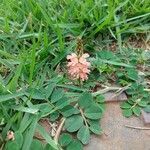Prostrate or ascending herb with a thick perennial rootstock; stems ridged, somewhat flattened, sparingly appressed strigulose, as are the leaf-rhachides and inflorescences.. Stipules broadly scarious at the base, tapering to a subulate tip, appressed strigulose, glabrescent at the margins; rhachis flattened, up to 3 cm. long, including a petiole of 1–3 mm., prolonged up to 3 mm. beyond the lateral leaflets; leaflets 5–11, most often 7, cuneate-obovate or cuneate-oblong, apiculate, varying greatly in size, ± 3 mm. long in reduced forms, ±10 mm. in average plants and up to 30 mm. in stout forms, usually strigulose on both surfaces, or, rarely, glabrous above.. Racemes densely many-flowered, the fertile portion 2 or more times as long as the 1–4 cm. long peduncle; bracts brownish, lanceolate, caducous; pedicels ± 0.5 mm. long.. Calyx appressed strigose, 2–3 mm. long, divided almost to the base.. Corolla sparsely strigulose outside.. Stamens 3–4 mm. long.. Style ± 1 mm. long, bent upwards near the base.. Fruit reflexed, straight or slightly downcurved, slightly tetragonal, strigulose, apiculate, often torulose when immature, 11–18 mm. long, ± 1.7 mm. wide and 2 mm. thick; endocarp not spotted.. Seeds 5–8, subglobular, yellow, smooth.. Fig. 46/17.
Perennial herb with ± prostrate stems to 0.8 m long. Stems flattened or angular, sparsely appressed strigose, arising from a woody rootstock or sometimes from old stem bases, forming large dense mats. Stipules 4-9(20) x up to 2 mm wide, triangular-lanceolate, broadly scarious at base, midrib mostly prominent, continuing as a setaceous tip. Leaves pinnately (3)5-8(9)-foliolate; leaf axis 7-28(40) mm long, including petiole of 1-3(9) mm, stipels present; terminal leaflet (4)8-26(29) x 4-13(15) mm, obovate-cuneate or elliptic, densely appressed strigillose above and beneath, sometimes glabrescent above. Racemes 4-10(14) cm long, including peduncle of 10-25(70) mm; bracts 1-3(5) mm long, lanceolate or ± trowel-shaped; pedicels 0.5-1 mm long. Calyx (2.5)3-4(5) mm long, densely strigose to subsericeous, ± equal or slightly exceeding stamens; lobes narrowly lanceolate-subulate, 2-3 times as long as tube. Keel apex ± acute. Stamens 2.8-3.5(4) mm long. Pod (10)13-23(30) x 1.5-2.5 mm, deflexed to spreading, subcylindrical to 4-angled, ± constricted at intervals when young, straight, densely appressed strigose becoming sparse later, drying straw-coloured. Seeds 4-10, 1.5-2 x 1.2-1.5 mm, ± squarish to globular, dark orange to blackish brown.
A herb. The stems lie along the ground and are 80 cm long. The stems are angular or flattened. The leaves are compound. There are many flowers in a group. The pods can be curved. They are 11-18 mm long and 1.7 mm wide. There are 5-8 seeds. They are yellow.
Suberect or prostrate herb, woody below
